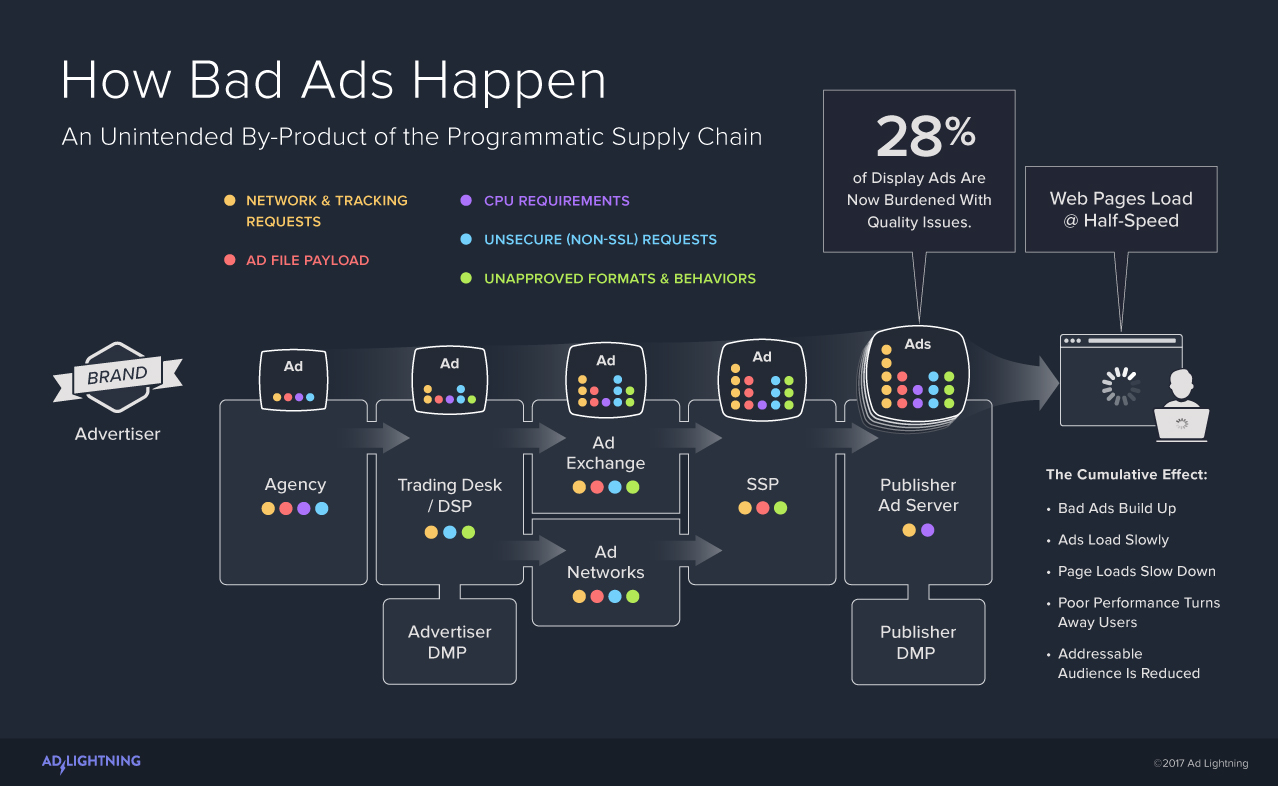By Scott Moore

Next time you’re waiting for a page to load on your favorite website, don’t curse the publisher. Blame the advertising industry.
The content you’re waiting for is likely being held up by the ads that surround it. When banner ads are too large, or burdened with other formatting or delivery issues, they take significantly longer to load. Last quarter, my company decided to look into this with an in-depth ad quality study. What we found was pretty startling: nearly one out of every three display ads has at least one serious ad quality issue. For example, 41% of banner ad files exceed the industry file size guidelines established by IAB. That’s just one of several issues that are adding up to a whole lot of waiting by internet audiences. On average, we found that consumers are now waiting twice as long for web pages with ads to load than the same pages without ads. The IAB New Ad Portfolio has even stricter guidelines.
Ad-related site latency is a wide-spread user experience issue that’s threatening both the brands and ad revenues of online publishers. As industry insiders, we can all get too close to the subject to realize it. But consider this: the folks who run your favorite website want that page to load much, much faster, but the ad issues creating the delays are neither caused nor controlled by the website’s publisher. Moreover, when ad quality issues slow page loads to a crawl, they can be very difficult for the publisher to identify, address and quantify.
Of course, that’s not just bad news for publishers. The reality is that bad ads affect the entire digital advertising industry, not just publishers. Ad quality issues slow page loads. When ads affect user experiences, audiences turn away, view fewer pages and even adopt ad blocking technologies. All of those outcomes reduce the addressable audience for digital advertising and that’s a problem for everyone involved in the programmatic ecosystem.
In order to understand the scope and nuances of the problem, we identified the five most pervasive ad quality issues and examined their frequency and magnitude, including file size. The issue of “over-requested ads” also topped the list. Those tracking pixels advertisers use to track and measure ads? They are also a problem. As the ads go through the programmatic mosaic to find their audience, additional tags, beacons, user syncs, and cookie syncs accumulate and increase the ad load. In order to keep ad requests manageable, IAB suggests a maximum of 15 network requests/tracking scripts per ad. However, by the time the ads attempt to load on a webpage, the average number of trackers has ballooned to 56 per ad, nearly four times the IAB maximum.
The problem stems from the way programmatic advertising currently works. A 2016 report by eMarketer estimates that about two-thirds of all display advertising is now handled programmatically. In order to participate in what has become the dominant display ad marketplace, online publishers must cede control of programmatic ads to programmatic technology partners. By letting go of those reins, they’ve opened their websites up to a number of ad quality issues that cumulatively affect website performance, chip away at audience numbers and reduce the number of page views on their websites.
Ad quality issues are occurring at alarming rates. About one third of the ads examined in our study were overly processor-intensive. More than half of the ad trackers were non-SSL compliant. Across the board, there is a huge gap between the ad quality guidelines established by IAB and actual industry practices. However, it’s the cumulative effect that’s most concerning. The issues occur so frequently that half-speed is becoming the standard experience for visitors of ad-supported websites.
It’s an issue created by our own industry, so we can solve it too. Facebook, for example, has taken a more stringent approach to quality, partnership, and control that has enabled them to avoid ad quality issues and protect the user experience. While that makes it more difficult for publishers to compete with Facebook and more difficult for advertisers to reach consumers beyond Facebook, it also highlights the opportunity and potential if we address ad quality issues across the board.
Site performance issues can also affect the public’s perception of a publisher’s brand. Derek Gatts, Global Head of Ad Traffic, Technology & Product at Bloomberg Media, describes the challenge of balancing ad operations and brand protection, “Bloomberg has prioritized the safety and speed of our users’ experience across our platforms. In 2016, we made our content and advertising 100% SSL compliant, shifted to 100% HTML5 and took a number of other steps that cut our page load time in half. Going forward, we’ve committed to aligning with all industry specifications. Using ad monitoring technologies that enable us to identify and address quality issues proactively, we can continue to meet the objectives of our advertisers while maintaining a fast, elegant experience for our users.”
There are steps that each ecosystem participant can take to ensure that the programmatic process itself doesn’t create or exacerbate ad quality issues. Like other industrial supply chains, all of the companies involved should play a role in assuring compliance with industry guidelines and, at each step, implement quality control steps that either flag, fix or reject ad units that are out of spec.
- Agencies and Advertisers can adhere to industry quality guidelines & principles for every ad, every campaign. Utilize third-party tools to automate QA processes and catch issues early.• Demand-Side Platforms (DSP) should strictly enforce creative specs for agencies and advertisers. Deploy ad tag scanning tools to catch bad actors early and identify vulnerabilities. Foster open communication with inventory sources to help quickly block bad ads.
- Ad Networks and Ad Exchanges must work to ensure that bidding, data and trafficking practices aren’t adding excessive scripts, especially non-secure scripts, to the ad payload. Be selective about your demand sources and hold them accountable for high quality standards. Consistently scan ads to catch violations and share bad-ad information with demand partners to prevent future occurrences.
- Supply-Side Platforms (SSPs & Header Bidders) should hold exchanges and networks accountable for good creative. Proactively stop bad ads from reaching publishers by building whitelists/blacklists and consistently checking creative against them. Support tools that allow publishers to find and report problematic creative that makes it to their site.
- Publishers must continuously monitor their websites, not just ad tags, for creative violations. Use tools that detect ad quality issues and provide feedback mechanisms to quickly take action.
Unfortunately, today, most companies in the programmatic ecosystem aren’t doing enough to detect and address ads that have quality issues. Until the ad industry makes a concerted effort to enact quality checks and balances, the problems are left to publishers to solve or internet audiences to bear. And that hurts the ad industry as a whole.
ABOUT THE AUTHOR

Scott Moore is a digital publishing veteran and CEO of Ad Lightning. Follow him at @scottm00re or at https://www.linkedin.com/in/scottmo